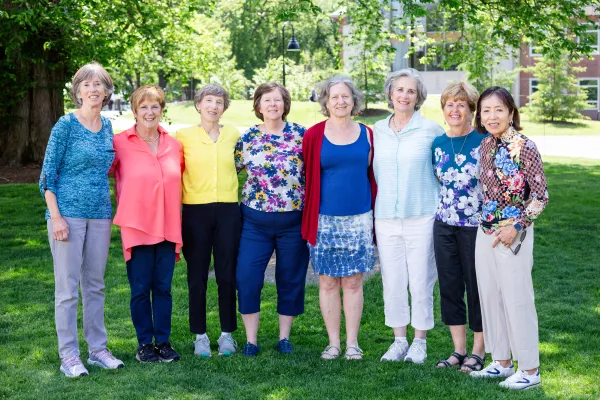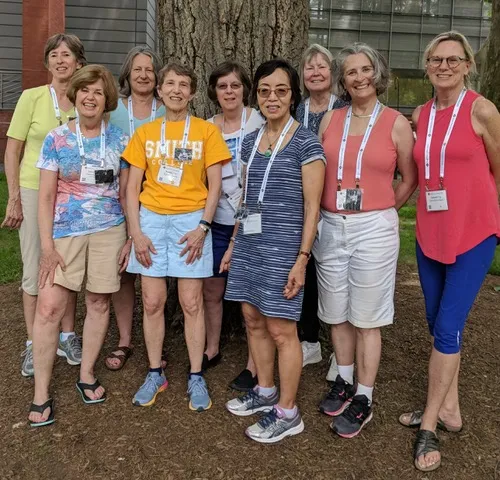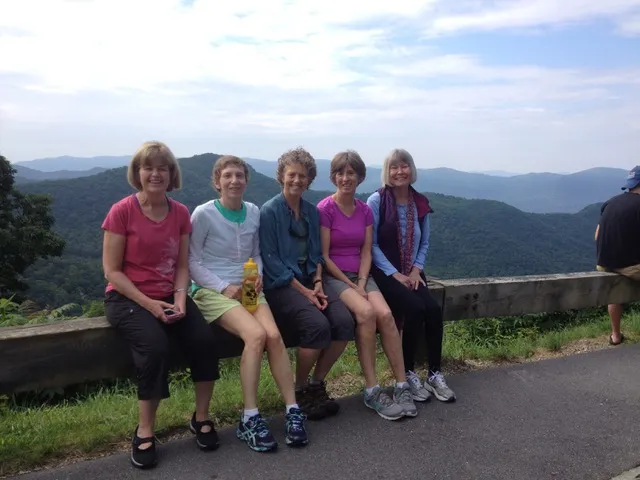Class of 1973 Tapestry Giving Circle Honors Indelible Friendships Born at Smith
Alum News
Eight members of the Class of 1973 Tapestry Giving Circle came to campus for their 50th Reunion in 2023, from left: Ellen Reath, GiGi Benjamin, Robbie Lipsman, Sue Cohn, Lindsey Lang, Sherry Dickstein, Laurie Woodard, and Gloria Eng. (Not present: Laurel Davis Huber, Margie Stetson, and Lisa Westerback.) Photograph by Lindsey McGrath
Published September 10, 2024
How do you memorialize a circle of friends that’s seen you through joy, heartache, and everything in between for decades? Eleven alums from the class of 1973 are celebrating the indelible bonds formed during their Smith years—along with the memories and gratitude they have generated—with an endowed scholarship fund.
You’d think that giving circles were invented for this.
“We could have built a monument or a sculpture to honor our love for one another, but this is a living testament to a friendship that is only growing richer,” says Laurie Woodard about the Class of 1973 Tapestry Giving Circle that she and her classmates created in the lead-up to their 50th Reunion. Named after Carole King’s chart-topping album Tapestry (the virtual soundtrack of these alums’ junior and senior years and an apt metaphor for the group’s cohesion), this giving circle will provide financial aid support to Smith students in perpetuity. “This circle will go on indefinitely,” says Woodard, “and we hope that it will allow future Smithies to find the friendship and other joys in life that we have.”
Robbie Lipsman encapsulates the trust shared by this group, who despite physical distance (they are broadly spread from the East Coast to Colorado) have always been there for each other: “The Tapestry ’73 women have held me together throughout my adult life. They do not need explanations. They know my life story. They are unlike any other friendships I have had.”
Emerson House in tumultuous times
“Emerson House is etched in my mind as an indication of how much life changed,” says Woodard about the place where the majority of these women met and the tumult that marked their college years. They came to Smith with the echoing chords of Woodstock and graduated as the Senate Watergate Committee hearings started.
When they moved into Emerson, house mothers ruled. Men were not allowed. Emersonians donned skirts for a candlelit dinner once a week. By senior year, blue jeans were de rigueur, house mothers had a greatly reduced role, men visited, and that fancy formal dinner? Gone.
Members of the group started protesting the Vietnam War and waited anxiously as relatives and friends received draft lottery numbers.
“There was a societal expectation that changed for women during those years,” says Lipsman, remembering how much more independent and career-focused Smith graduates became in four short years.
“It was staggering how different the world was when we graduated,“ says Ellen Reath. “And maybe that’s one reason we bonded so much—our eyes were opened.”
Keeping the connection alive
After leaving Smith, the friends largely followed parallel tracks: graduate education, marriage or partnership, children. They kept in touch and enjoyed seeing each other both at Smith Reunions and on vacations, often planned as a group. But they connected as schedules allowed, busy with careers and families, and rarely managed to be together all at once.
Lipsman, Margie Stetson, Ellen Reath, and Lisa Westerback.
In 2012, they assembled on campus to see Barbara Brenner, classmate and member of their close Emerson group, receive the Smith College Medal. Dubbed “the pit bull of breast cancer,” Brenner was a powerhouse in breast cancer research advocacy as executive director of Breast Cancer Action, a grassroots organization. The next year, Brenner died of amyotrophic lateral sclerosis (ALS). The death shook the friends deeply. “We realized that it was important to put energy into meeting as a group, that it shouldn’t be so casual anymore,” says Woodard.
Less than a decade later, the remaining 11 friends helped hold each other together with regular weekly Zoom calls, as lives were turned upside down by the pandemic.
Why a Here for Every Voice giving circle?
Sherry Dickstein started the ball rolling on the giving circle. “I was inspired by President Emerita McCartney removing loans from scholarship packages,” she says. “That’s huge. It will change lives. It made me want to give more to help students be able to attend Smith.”
Dickstein reached out to Woodard to discuss the possibility of a scholarship fund. They were both attracted to the permanency of an endowed fund and hoped that through collective giving they could attain the level to receive the Here for Every Voice gift match.
After approaching Laurel Davis Huber, who was positive, they brought the idea to the entire group. “Several of us had already committed to giving to Smith in other ways to mark our 50th Reunion,” says Dickstein, “and yet they still wanted to join this circle and give more.”
Weaving the future
The women of the Tapestry Giving Circle are excited by the impact this fund will have on future Smithies. For all, this is very personal.
Gloria Eng remembers being “crushed” when Smith did not offer her family financial aid. She started receiving financial aid in her sophomore year. (Today, Smith is able to meet the full financial need of all enrolled students.) Eng is delighted to be doing her part to ensure that no future student needs to say no to Smith for financial reasons.
GiGi Benjamin sees the “awe- inspiring” intergenerational impact this support from alums carries for current students. “How empowering it must feel to a young woman to know that there’s a group of women behind her that she’s never met.”
For Lindsey Lang, who came up with the idea to name the circle after the Tapestry album, it’s all about giving future Smithies a chance to find their own trusting communities. “The Tapestry Giving Circle is a tangible manifestation of what results when individuals intertwine the strands of their lives into a strong and loving network. We have received so much from our friendship, which never would have happened without Smith, that we want to give back so other students can discover what we did and create their own wondrous woven magic.”
Dickstein sums it up simply: “The Tapestry Giving Circle is hope for the future.”
For more information and to make a gift, please contact: Betsy Carpenter ’93, Associate Vice President for Development


